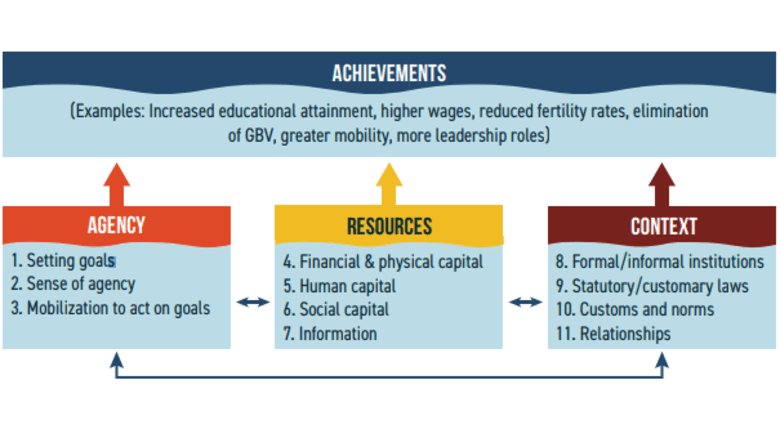Using an Empowerment Approach to Design Development Projects
The (WGE) offers a three step process to design a project that empowers women or girls to reach a particular objective:
First - define a specific achievement the project hopes to empower women and/or girls to realize, such as reducing a specific gender gap or improving a specific outcome;
Second - identify the constraints within each pillar that prevent women and/or girls from realizing that achievement; and
Third - select the most critical constraints and design project activities to help women overcome them, accordingly.
Practitioners can build out interventions under the agency and context pillars by drawing on . For example, context interventions in Uganda, Malawi, Kenya, and Rwanda have successfully engaged men and community leaders to abandon harmful or restrictive social norms. Agency interventions in Liberia, Kenya, and Uganda offering agency-based empowerment training or organizing women into self-help groups have increased beneficiaries¡¯ confidence and determination in reaching their goals.
Lessons from the Field
A recent of the World Bank¡¯s Social Protection and Jobs (SPJ) portfolio in Africa provides insights on adopting the operational approach to WGE in practice:
- Transformational change requires interventions from multiple pillars. Successful projects layer interventions to provide women with resources, strengthen their agency and voice, and, in the context pillar, facilitate positive social norms change.
- Projects can promote WGE alongside core sectoral objectives. While projects may, for instance, primarily aim to reduce poverty or improve employment outcomes, they will better reach these goals if WGE interventions are incorporated. Such pairing will be more effective than a women¡¯s empowerment project that is not tethered to a sector-specific outcome.
- Projects can incorporate WGE interventions gradually during implementation. While several projects include WGE interventions as part of initial project design, many incorporate transformative interventions after client buy-in and delivery capacity are established. , for example, the safety nets project gradually phased in WGE adaptations such as the provision of childcare and temporary latrines at work sites.
Measuring Women & Girls Empowerment Across the Three Pillars
Measurement is critical to understanding what interventions drive progress towards WGE. Yet standardized measurement is challenging since WGE encompasses many dimensions of women¡¯s economic and social lives.
This simplifies the process by identifying four proxy measures of the three empowerment pillars:
- Input into decisions (agency): The extent to which respondents have input into key household decisions and whether they can make personal decisions.
- Self-efficacy (agency): The belief in one¡¯s ability to act effectively towards a goal.
- Asset ownership (resources): Whether the respondent has the ability to sell, rent out, or give away durable assets possessed by the household.
- Sharing of housework (context): The extent to which the respondent and her spouse/partner share responsibility for the home and childcare.
The guide provides accessible guidance on data collection and analysis.



